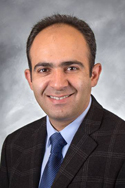Associate professor in electrical and computer engineering earns $475,000 NSF grant to miniaturize additive manufacturing technique
Published: Aug 27, 2024 7:40 AM
By Joe McAdory
Masoud Mahjouri-Samani, the Godbold Associate Professor of Electrical and Computer Engineering, intends to push the boundaries of laser-based powder-bed fusion additive manufacturing to micro and nanoscale, one nanoparticle at a time.
Mahjouri-Samani’s proposal, “Three-Dimensional Printing of Compositionally Tunable and Hybrid Microarchitectures by Laser Nanoparticle Powder-Bed Fusion,” recently earned a three-year, $475,000 grant from the National Science Foundation.
“In conventional powder-bed additive manufacturing process, microscale particles — ranging from 20 to 50 microns in diameter — are laser-fused layer-by-layer forming macro architectures and parts, typically lacking functionality,” he said.
“Imagine this … shrinking it down tens of thousands of times. We are developing non-equilibrium laser processes to generate, coat, and fuse nanoparticles in situ and in real-time a few nanometers thick at a time, pulse-by-pulse and layer-by-layer. We are creating the smallest powder bed additive manufacturing, or nanoparticle bed fusion additive nanomanufacturing, process. Now we can start integrating different materials and creating nano and microarchitectures with tunable compositions enabling functional devices.”
The research further explores the interface interactions and laser sintering process of the nanoparticle assemblies at various energy and time scales to better understand their sintering, phase evolution, intermixing, and alloying mechanisms. It will also examine the structural and morphological evolution of the 3D printed nanocomposites and heterostructures, elucidating their process-structure-property relationships.
But it doesn’t come without uncertainties. How will these nanoparticles be generated? How will it be coated uniformly? How will the nanoparticles interact with one another? What happens when a laser is applied to them at various time and energy scales?
“These are the fundamental questions — among others — we’re going to answer with this grant,” Mahjouri-Samani said. “We look forward to using these answers to revolutionize advanced manufacturing.”
Mahjouri-Samani believes the outcome can improve applications in the electronics, energy, healthcare, biomedical, and aerospace industries.
“We hope that results of the research will positively impact the U.S. economy with the creation of functional 3D microarchitectures and applications, make a positive impact on society through technological advancement, and by educating the next generation of our scientific workforce.”
Media Contact: , jem0040@auburn.edu, 334.844.3447
Masoud Mahjouri-Samani, associate professor of electrical and computer engineering, works with graduate student Aarsh Patel, left.


